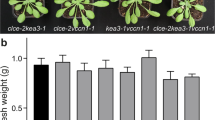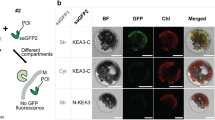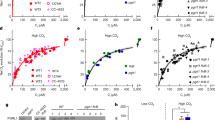Abstract
In photosynthetic thylakoid membranes the proton motive force (pmf) not only drives ATP synthesis, in addition it is central to controlling and regulating energy conversion. As a consequence, dynamic fine-tuning of the two pmf components, electrical (Δψ) and chemical (ΔpH), is an essential element for adjusting photosynthetic light reactions to changing environmental conditions. Good evidence exists that the Δψ/ΔpH partitioning is controlled by thylakoid potassium and chloride ion transporters and channels. However, a detailed mechanistic understanding of how these thylakoid ion transporter/channels control pmf partitioning is lacking. Here, we combined functional measurements on potassium and chloride ion transporter and channel loss-of-function mutants with extended mathematical simulations of photosynthetic light reactions in thylakoid membranes to obtain detailed kinetic insights into the complex interrelationship between membrane energization and ion fluxes across thylakoid membranes. The data reveal that potassium and chloride fluxes in the thylakoid lumen determined by the K+/H+ antiporter KEA3 and the voltage-gated Cl− channel VCCN1/Best1 have distinct kinetic responses that lead to characteristic and light-intensity-dependent Δψ/ΔpH oscillations. These oscillations fine-tune photoprotective mechanisms and electron transport which are particularly important during the first minutes of illumination and under fluctuating light conditions. By employing the predictive power of the model, we unravelled the functional consequences of changes in KEA3 and VCCN1 abundance and regulatory/enzymatic parameters on membrane energization and photoprotection.
This is a preview of subscription content, access via your institution
Access options
Access Nature and 54 other Nature Portfolio journals
Get Nature+, our best-value online-access subscription
$29.99 / 30 days
cancel any time
Subscribe to this journal
Receive 12 digital issues and online access to articles
$119.00 per year
only $9.92 per issue
Buy this article
- Purchase on Springer Link
- Instant access to full article PDF
Prices may be subject to local taxes which are calculated during checkout





Similar content being viewed by others
Data availability
The data sets generated during and/or analysed during the current study are available from the corresponding author on reasonable request.
Code availability
The computer code for our model is available online. A link is provided in Supplementary Information.
References
Mitchell, P. Coupling of photophosphorylation to electron and hydrogen transfer by a chemiosmotic type of mechanism. Nature 191, 144–148 (1961).
Williams, R. J. P. Possible functions of chains of catalysts. J. Theor. Biol. 1, 1–13 (1961).
Williams, R. J. P. Possible functions of chains of catalysts II. J. Theor. Biol. 3, 209–220 (1962).
Witt, H. T. Energy conversion in the functional membrane of photosynthesis. Analysis by light pulse and electric pulse methods: the central role of the electric field. Biochim. Biophys. Acta 505, 355–427 (1979).
Bulychev, A. A. & Vredenberg, W. J. Light-triggered electrical events in the thylakoid membrane of plant chloroplasts. Physiol. Plant. 105, 577–584 (1999).
Kramer, D. M., Cruz, J. A. & Kanazawa, A. Balancing the central roles of the thylakoid proton gradient. Trends Plant Sci. 8, 27–32 (2003).
Allorent, G. et al. Global spectroscopic analysis to study the regulation of the photosynthetic proton motive force: a critical reappraisal. Biochim. Biophys. Acta Bioenerg. 1859, 676–683 (2018).
Klughammer, C., Siebke, K. & Scheiber, U. Continuous ECS-indicated recording of the proton-motive charge flux in leaves. Photosynth. Res. 117, 471–487 (2013).
Davis, G. A., Rutherford, A. W. & Kramer, D. M. Hacking the thylakoid proton motive force for improved photosynthesis: modulating ion flux rates that control proton motive force partitioning into Δψ and ΔpH. Philos. Trans. Roy. Soc. B 372, 20160381 (2017).
Avenson, T., Cruz, J. A. & Kramer, D. Modulation of energy dependent quenching of excitons (qE) in antenna of higher plants. Proc. Natl Acad. Sci. USA 101, 5530–5535 (2004).
Rumberg, B. & Siggel, U. pH changes in the inner phase of the thylakoids during photosynthesis. Z. Naturwiss 56, 130–132 (1969).
Kobayashi, Y., Inoue, Y., Shibata, K. & Heber, U. Control of electron flow in intact chloroplasts by intathylakoid pH, not by the phosphorylation potential. Planta 146, 481–486 (1979).
Ruban, A. V. Light harvesting control in plants. FEBS Lett. 592, 3030–3039 (2018).
Li, Z., Wakao, S., Fischer, B. B. & Niyogi, K. K. Sensing and responding to excess light. Annu. Rev. Plant Biol. 60, 239–260 (2009).
Pinnola, A. & Bassi, R. Molecular mechanisms involved in plant photoprotection. Biochem. Soc. Trans. 46, 467–482 (2018).
Armbruster, U., Correa Galvis, V., Kunz, H. H. & Strand, D. D. The regulation of the chloroplast proton motive force plays a key role for photosynthesis in fluctuating light. Curr. Opin. Plant Biol. 37, 56–62 (2017).
Demmig, B. & Gimmler, H. Properties of the isolated intact chloroplast at cytoplasmic K+ concentrations in spinach chloroplasts. Plant Physiol. 73, 169–174 (1983).
Robinson, S. P. & Downtown, W. J. Potassium, sodium, and chloride content of isolated intact chloroplasts in relation to ionic compartmentation in leaves. Arch. Biochem. Biophys. 228, 197–206 (1984).
Schonknecht, G., Hederich, R., Junge, W. & Raschke, K. A voltage-dependent chloride channel in the photosynthetic membrane of a higher plant. Nature 336, 589–592 (1988).
Enz, C., Steinkamp, T. & Wagner, R. Ion channels in the thylakoid membrane (a patch-clamp study). Biochim. Biophys. Acta 1143, 67–76 (1993).
Finazzi, G. et al. Ion channels/trasnporters and chloroplast regulation. Cell Calcium 58, 86–97 (2015).
Spetea, C. et al. An update on the regulation of photosynthesis by thylakoid ion channels and transporters in Arabidopsis. Physiol. Plant. 161, 16–27 (2017).
Kunz, H. H. et al. Plastidial transporters KEA1, -2, and -3 are essential for chloroplast osmoregulation, integrity, and pH regulation in Arabidopsis. Proc. Natl Acad. Sci. USA 111, 7480–7485 (2014).
Duan, Z. et al. A bestrophin-like protein modulates the proton motive force across the thylakoid membrane in Arabidopsis. J. Integr. Plant Biol. 58, 848–858 (2016).
Herdean, A. et al. A voltage-dependent chloride channel fine-tunes photosynthesis in plants. Nat. Commun. 7, 11654 (2016).
Herdean, A. et al. The Arabidopsis thylakoid chloride channel AtCLCe functions in chloride homeostasis and regulation of photosynthetic electron transport. Front. Plant Sci. 7, 115 (2016).
Marmagne, A. et al. Two members of the Arabidopsis CLC (chloride channel) family, ATCLCe and AtCLCf, are associated with thylakoid and Golgi membranes, respectively. J. Exp. Bot. 58, 3358–3393 (2007).
Carraretto, L. et al. A thylakoid-located two-pore K+ channel controls photosynthetic light utilization in plants. Science 342, 114–118 (2013).
Höhner, R. et al. Photosynthesis in Arabidopsis is unaffected by the function of the vacuolar K+ channel TPK3. Plant Physiol. 180, 1322–1335 (2019).
Jaslan, D. et al. Voltage-dependent gating of SV channel TPC1 confers vacuole excitability. Nat. Commun. 10, 2659 (2019).
Tang, R.-J. et al. A calcium signalling network activates vacuolar K+ remobilization to enable plant adaptation to low-K environments. Nat. Plants 6, 384–393 (2020).
Dukic, E. et al. K+ and Cl− channels/transporters independently fine-tune photosynthesis in plants. Sci. Rep. 9, 8639 (2019).
Armbruster, U. et al. Ion antiport accelerates photosynthetic acclimation in fluctuating light environments. Nat. Commun. 5, 5439 (2014).
Wang, C. & Shikanai, T. Modification of activity of the thylakoid H+/K+ antiporter KEA3 disturbs ΔpH15 dependent regulation of photosynthesis. Plant Physiol. 181, 762–773 (2019).
Tian, L. et al. pH dependence, kinetics and light-harvesting regulation of nonphotochemical quenching in Chlamydomonas. Proc. Natl Acad. Sci. USA 116, 8320–8325 (2019).
Takizawa, K., Cruz, J. A. & Kramer, D. M. Depletion of stromal inorganic phosphate induces high ‘energy-dependent’ antenna exciton quenching (qE) by decreasing proton conductivity at CFO-CF1 ATP synthase. Plant Cell Environ. 31, 235–243 (2008).
Cruz, J. A., Sacksteder, C. A., Kanazawa, A. & Kramer, D. M. Contribution of electric field (Δψ) to steady-state transthylakoid proton motive force (pmf) in vitro and in vivo. Control of pmf parsing into Δψ and ΔpH by ionic strength. Biochemistry 40, 1226–1237 (2001).
Bailleul, B., Cardol, P., Breyton, C. & Finazzi, G. Electrochromism: a useful tool to study algal photosynthesis. Photosynth. Res. 106, 179–189 (2010).
Schuldiner, S., Rottenberg, H. & Avron, M. Determination of ΔpH in chloroplasts. 2. Fluorescent amines as a probe for the determination of ΔpH in chloroplasts. Eur. J. Biochem. 25, 64–70 (1972).
Johnson, M. P., Zia, A. & Ruban, A. V. Elevated ΔpH restores rapidly reversible photoprotective energy dissipation in Arabidopsis chloroplasts deficient in lutein and xanthophyll cycle activity. Planta 235, 193–204 (2011).
Jahns, P. & Holzwarth, A. R. The role of the xanthophyll cycle and of lutein in photoprotection of photosystem II. Biochim. Biophys. Acta 1817, 182–193 (2012).
Nielkens, M. et al. Idnetification of a slowly inducible zeaxanthin-dependent component of non-photochemical quenching of chlorophyll fluorescence generated under steady-state conditions in Arabidopsis. Biochim. Biophys. Acta 1797, 466–475 (2010).
Correa Galivs, V. et al. H+ transport by K+ exchange antiporter3 promotes photosynthesis and growth in chloroplast ATP synthase mutants. Plant Physiol. 182, 2126–2142 (2020).
Wang, C. et al. Fine-tuned regulation of the K+/H+ antiporter KEA3 is required to optimize photosynthesis during induction. Plant J. 89, 540–553 (2017).
Armbruster, U. et al. Regulation and levels of the thylakoid K+/H+ antiporter KEA3 shape the dynamic response of photosynthesis in fluctuating light. Plant Cell Physiol. 57, 1557–1567 (2016).
Roosild, T. P. et al. KTN (RCK) domains regulate K+ channels and transporters by controlling the dimer-hinge conformation. Structure 17, 893–903 (2009).
Uflewski, M. et al. Functional characterization of proton antiport regulation in the thylakoid membrane. Plant Physiol. https://doi.org/10.1093/plphys/kiab135 (2021).
Gräber, P., Junesch, U. & Schatz, G. H. Kinetics of proton-transport coupled ATP synthesis in chloroplasts. Activation of the ATPase by an artificially generated ΔpH and Δψ. Ber. Bunsenges. 88, 599–608 (1984).
Schneider, D. et al. Fluctuating light experiments and semi-automated plant phenotyping enabled by self-built growth racks and simple upgrades to the IMAGING-PAM. Plant Methods 15, 156 (2019).
Koochak, H., Puthiyaveetil, S., Mullendore, D. L., Li, M. & Kirchhoff, H. The structural and functional domains of plant thylakoid membranes. Plant J. 97, 412–429 (2019).
Van, T. V., Heinze, T & Rumberg, B . in Progress in Photosynthesis Research Vol. III (ed. Biggens J) (Martinus Nijhoff, 1987).
Tietz, S. et al. Functional implications of photosystem II crystal formation in photosynthetic membranes. J. Biol. Chem. 290, 14091–14106 (2015).
Kramer, D. M., Johnson, G., Kiirats, O. & Edwards, G. E. New fluorescence parameters for the determination of QA redox state and excitation energy fluxes. Photosynth. Res 79, 209–218 (2004).
Puthiyaveetil, S. et al. Compartmentalization of the protein repair machinery in photosynthetic membranes. Proc. Natl Acad. Sci. USA 111, 15839–15844 (2014).
Acknowledgements
We thank M. Wood and Dr D. Schneider at the WSU Plant Phenomics facilities for their assistance in acquiring phenotyping data. The work was mainly supported by a US Department of Energy grant (DE-SC0017160) to H.K. and H.-H.K. Additional support from the National Science Foundation (MCB-1616982) and USDA-NIFA (#1005351 and #0119) to H.K. and by the 3rd ERA-CAPS call via the NSF PGRP programme (IOS-1847382, 1847193) to H.-H.K. and D.M.K. is acknowledged. Support for modelling work at MSU was supported by award #1847193 from the National Science Foundation. The project was also made possible thanks to a Murdock trust equipment grant (# SR-2016049) to H.-H.K. and H.K.
Author information
Authors and Affiliations
Contributions
M.L., V.S., G.D. and H.-H.K. performed experiments and analysed data. M.L. G.D., D.K. H.-H.K. and H.K. designed the study. H.K. wrote the manuscript.
Corresponding author
Ethics declarations
Competing interests
The authors declare no competing interests.
Additional information
Peer review information Nature Plants thanks Conrad Mullineaux, Toshiharu Shikanai and the other, anonymous, reviewer(s) for their contribution to the peer review of this work.
Publisher’s note Springer Nature remains neutral with regard to jurisdictional claims in published maps and institutional affiliations.
Supplementary information
Supplementary information
Supplementary Methods, Supplementary Figs. 1–10, Supplementary References.
Rights and permissions
About this article
Cite this article
Li, M., Svoboda, V., Davis, G. et al. Impact of ion fluxes across thylakoid membranes on photosynthetic electron transport and photoprotection. Nat. Plants 7, 979–988 (2021). https://doi.org/10.1038/s41477-021-00947-5
Received:
Accepted:
Published:
Issue Date:
DOI: https://doi.org/10.1038/s41477-021-00947-5
This article is cited by
-
The thylakoid proton antiporter KEA3 regulates photosynthesis in response to the chloroplast energy status
Nature Communications (2024)
-
From leaf to multiscale models of photosynthesis: applications and challenges for crop improvement
Photosynthesis Research (2024)
-
Overdominant expression of related genes of ion homeostasis improves K+ content advantage in hybrid tobacco leaves
BMC Plant Biology (2022)
-
Cryo-EM structures of thylakoid-located voltage-dependent chloride channel VCCN1
Nature Communications (2022)



